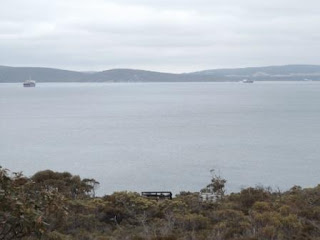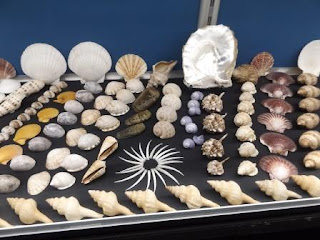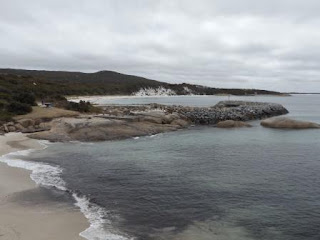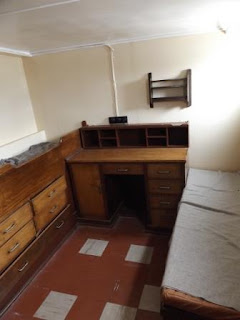7am
21.7 degrees – lovely temperature but it is overcast. Such a change from
yesterday’s perfect day. Decided to head into Albany to check out the historic
Whaling Station. Wayne & Tracy said it was amazing and to take all day as
there is so much to see. As it isn’t a nice day for scenery we headed off.
Jumpers on and a few spits of rain fell as we left.
Turned
right onto Frenchman Bay Road which follows a long peninsula south of Albany.
All
the way to the bottom then up to a lookout for a cuppa. Looking over Goode
Beach homes to grain silos on the foreshore and houses of Albany.
Scanned
around over the Quaranup Peninsula then Mistaken Island.
Then
over King George Sound, small Seal Island in front of Michaelmas Island then
Breaksea Island. Breaksea Island was where Bob’s grandmother, Faye Howe, was
living as a girl at the lighthouse with her family when the fleet headed out to
WW1. She communicated using semaphore flags with the Anzac soldiers while they
waited on their ships in the harbour before heading off to war at Gallipoli.
She then passed on their messages to their families etc via Morse code. She was
known as the Lighthouse Girl.
Finally
over the historic whaling station – one sign says Whale World, other historic
whaling station then on the brochure it is called Discovery Bay – bit
confusing.
The
lookout is named after Captain Vancouver who discovered this area in 1789.
I
walked down the track to check out the other info signs.
Coastal
Banksia.
Down
to Whale World. The last of the whaling ships has been saved and used in the
museum.
Fabulous
photo of the whaling station and part of Flinders Peninsula at the entrance.
Paid
our entrance fee and we were just in time to join the hourly guided tour. The
guide was great and it was great to hear all the stories. Cheynes Beach Whaling
Station operated here from 1952 to 1978. This is the last whaling station in
Australia which closed in 1978. This is the huge engine out of the Cheynes III
which was sunk as a dive wreck after the business closed. It still works but
only goes slowly compared to when it was making the ship go.
Finished
the tour watching a 3D movie called Giants Exist, an animated whale movie
telling us all about whales etc. Very good.
Wandered
around slowly checking out all the displays. Started with the skeleton display.
Amazing size of the jaw bones of a Blue Whale.
Fabulous
display.
This
shed was originally used to store the bagged whale solubles. Whale solubles
were 86% protein and it was exported as a protein supplement.
Across
from the skeletons was the Mess Room and Cook’s House beside that. Now it
houses a display of charts showing numbers of whales caught, photos and a video
of work being carried out at the station and when it was announced that whaling
would be stopped and interviews with the men affected by the closure of the
station.
Into
one of the huge oil storage tanks to watch a hologram story of the day in the
life of a whale catching family. It was really good. There are four tanks which
could hold oil from 70 to 100 whales at a time.
Into
the Engineering and Blacksmiths’ workshop which houses early whaling artefacts,
memorabilia, equipment and a replica ‘beetle class’ whale boat.
Captain
Steve steering then firing off the harpoon.
Continued
through the shed to where the power station was then the boiler room.
Newspaper
clipping about the end of the whaling station.
Cheynes
III which was scuttled – resting in 24 metres of water as a dive site.
At
the end of the boiler was a little room where the men would warm up.
Back
into the room with the Cheynes III engine which was part of the boiler’s shed.
Walked
out of the shed to where they pull up the whales using these big winches.
In
July 1957 a pipeline was laid underwater to facilitate the loading of whale oil
in bulk. Because great white sharks were ever present here this shark cage was
built to be used if there were any leaks in the line. Fortunately it was never
used.
The
Flensing Deck. Apparently the stench was incredible.
I
bet the beach didn’t look like this back then.
Once
the blubber was pulled off it and the rest of the whale was then hauled up onto
the next deck where it was cut up and put into the boilers below through 6
holes in the deck. Every part of the whale was used.
Into
the Fisheries Office.
The
well-worn grinding stone the flensers sharpened their cutting blades on.
Down
underneath to the processing area where the oil was removed in these big
cookers. The remaining solids were then put through the dryer on the other
side.
Up
the stairs was an old towboat.
Into
the next shed where the solids were processed.
The
whale oil was filtered up in that shed which is used for site maintenance now.
Nice
playground and picnic area. Someone was cooking sausages which made us hungry
so we headed out for our lunch.
Back
inside the entrance area – nice set of choppers. 3.6m Great White Pointer’s
nasty teeth.
One
room had a fabulous shell collection. Hilda Hotker started collecting these
over 60 years. Beautifully laid out.
Outside
we checked out the Cheynes IV.
Great
view over Cheynes Beach then I zoomed in on the lighthouse on Breaksea Island.
Back over the processing area and whale oil tanks.
Lots
of information to read and things to see as we walked around the ship.
Narrow
beds for the crew – Chief Engineer had a nicer room.
Through
the engine room. Steep stairs to below.
Compact
kitchen. Steve found a book to read about the purchase of each of the company’s
ships.
The
cook had a nice room. Photo of the ship with a few whales hanging off the
sides.
I
climbed down the steps to the Spring Room. There was a dark room which was the
Sonar Pit.
The
springs were attached to the ropes that held the whales against the ship. They
stopped the ship being pulled over by the whales.
The
chain locker and other bits and pieces on display. Once they had killed the
whale they injected it with air to keep it afloat then put in a flag and beacon
then left it to search for more whales. At the end of the day they would come
back and collect the whales and head back to the Station.
Further
along towards the front of the ship was the cool room.
Into
the Captain’s quarters (his bed to the left of the lounge) and dining room.
Information
about various captains and crew.
Next
door was the radio room and chart room.
More
info.
Up
to the bridge area. The sonar room was locked – view to the stern from beside
it
Steve
is Captain today and when he sees a whale he will run down the platform to fire
the harpoon into the whale.
He
would communicate with the engine room etc through this pipe. Big compass.
The
front of the ship rises up steeply.
Steve
getting the whale in shot. Oops.
Walked
down onto the very sloping deck. All the spare harpoons, ropes and chains were
laid on the deck ready to tie up the whales.
Along
way up to the crow’s nest.
Walked
down to the stern – the big smoke stack coming up from the engine and air
ventilation for the engine room.
At
the rear is the emergency steering wheel. This wheel is attached directly to
rudder below. Otherwise it moves using the long rods on the deck.
More
info.
Into
the whale oil storage tanks to watch some more films. We stood for a while in
the dim light but nothing came on. Then we realised that the power was off
because on the ship there is usually a voice over talking and it wasn’t going
when we walked around the ship.
Walked up to the end tank which has lots of information about this company’s ships.
Other
historical info.
Windows
have been cut into the tank. Zoomed in on the lighthouse again.
The
lights came on so we headed back into one of the tanks to watch a show on
sharks using three big screens. Interesting how everyone got on board to
protect the whales but it was much harder to convince people to save the
sharks.
In
the next one the screen was on the floor and we stood around the edge of the
tank on a platform. It was about whaling history – very interesting. I don’t
think they cleaned all the oil out of this tank as it stank and there was furry
bits on the walls.
In
the old store and radio workshop was a display of sepia photography.
A
whale being cut up and a flenser sharpening his knife.
To
finish off I climbed up into the Crow’s Nest. Sounds challenging but they have
it on the ground now!! Should have got Steve to lay on the ground and shoot
straight up for a more realistic photo.
Chatted
with a guy who came here as a school student in 1970 when people could stand
behind a fence and watch the men cutting up the whales. He said he can still
remember the smell and there were sharks coming up onto the slipway to drag
parts of the whales back into the water.
Back
into the main area and gift shop we found another room. Full of info about all
the different whales, dolphins, seals etc – there are so many.
Also
a display of whale bone and tooth carvings called Scrimshaw.
We
had a great day even though the day was on and off mist then sunshine. We could
also have gone into the Wildflower Garden and Wildlife Park but we had had enough.
Drove down to the beach for a cuppa. Certainly a different day to yesterday. As
we were leaving the rain got heavier.
The
toilet block had a nice front.
Wet
drive back to the van. All closed up again as it is cold!!








































































































































































































































No comments:
Post a Comment